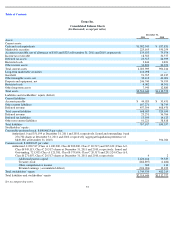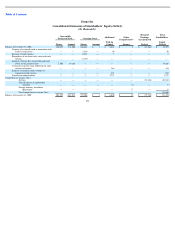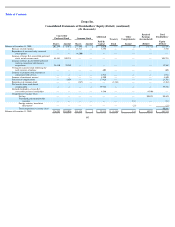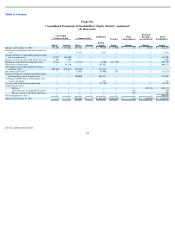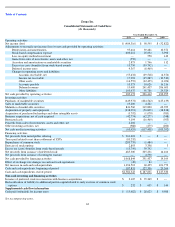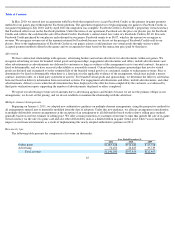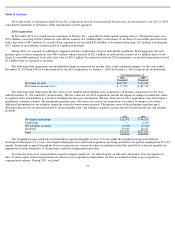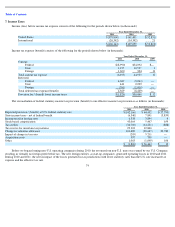Zynga 2011 Annual Report Download - page 68
Download and view the complete annual report
Please find page 68 of the 2011 Zynga annual report below. You can navigate through the pages in the report by either clicking on the pages listed below, or by using the keyword search tool below to find specific information within the annual report.
Table of Contents
consolidated basis for purposes of allocating resources. When evaluating performance and allocating resources, the CODM reviews financial
information presented on a consolidated basis, accompanied by disaggregated bookings information for our games.
Revenue Recognition
We derive revenue from the sale of virtual goods associated with our online games and the sale of advertising within our games.
Online Game
We operate our games as live services that allow players to play for free. Within these games, players can purchase virtual currency to
obtain virtual goods to enhance their game-playing experience. Players can pay for our virtual currency using Facebook Credits when playing
our games through the Facebook platform, and can use other payment methods such as credit cards or PayPal on other platforms. We also sell
game cards that are initially recorded as a customer deposit liability which is included in other current liabilities on the consolidated balance
sheet, net of fees retained by retailers and distributors. Upon redemption of a game card in one of our games and delivery of the purchased
virtual currency to the player, these amounts are reclassified to deferred revenue. Advance payments from customers that are non-
refundable and
relate to non-cancellable contracts that specify our obligations are recorded to deferred revenue. All other advance payments that do not meet
these criteria are recorded as customer deposits.
We recognize revenue when all of the following conditions are satisfied: (1) there is persuasive evidence of an arrangement; (2) the service
has been provided to the player; (3) the collection of our fees is reasonably assured; and (4) the amount of fees to be paid by the player is fixed or
determinable. For purposes of determining when the service has been provided to the player, we have determined that an implied obligation
exists to the paying player to continue displaying the purchased virtual goods within the online game over their estimated life or until they are
consumed. The proceeds from the sale of virtual goods are initially recorded in deferred revenue. We categorize our virtual goods as either
consumable or durable. Consumable virtual goods represent goods that can be consumed by a specific player action. For the sale of consumable
virtual goods, we recognize revenue as the goods are consumed, which approximates one month. Durable virtual goods represent virtual goods
that are accessible to the player over an extended period of time. We recognize revenue from the sale of durable virtual goods ratably over the
estimated average playing period of paying players for the applicable game, which represents our best estimate of the estimated average life of
durable virtual goods. If we do not have the ability to differentiate revenue attributable to durable virtual goods from consumable virtual goods
for a specific game we recognize revenue on the sale of durable and consumable virtual goods for that game ratably over the estimated average
period that paying players typically play that game.
Prior to October 1, 2009, we did not have the data to determine the consumption dates for our consumable virtual goods or to differentiate
revenue attributable to durable virtual goods from consumable virtual goods. Beginning in October 2009, we had sufficient data to separately
account for consumable and durable virtual goods in one of our games, thus allowing us to recognize revenue related to consumable goods upon
consumption. Since January 2010, we have had this data for substantially all of our games thus allowing us to recognize revenue related to
consumable goods upon consumption. Future usage patterns may differ from historical usage patterns and therefore the estimated average
playing periods may change in the future. We assess the estimated average playing period for paying players and the estimated average life of
our virtual goods quarterly. Cumulative changes in estimated average playing period for paying players in 2011 resulted in an increase in
revenue of $53.9 million and will result in an offsetting reduction of 2012 revenue in the same amount.
We estimate chargebacks from Facebook and third-party payment processors to account for potential future chargebacks based on
historical data and record such amounts as a reduction of revenue.
64





